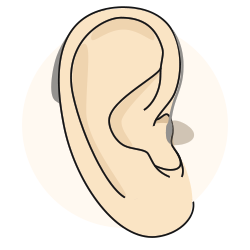Which Type Of Hearing Aid Will Work For You?
Good news! Hearing aid technology is rapidly advancing.
There are many types of hearing aids available — from completely invisible aids that rest in the ear canal, to hearing devices custom-molded to fit in your ear, to the familiar behind-the-ear hearing devices. There are even hearing aids that stream phone calls and music wirelessly from your iPhone and assistive devices for special hearing needs.
Hearing aids can’t restore your hearing. But they can amplify sounds to help improve your hearing. Come in and talk to us — we’ll explain the types of hearing aids available and which are best suited to your hearing needs.
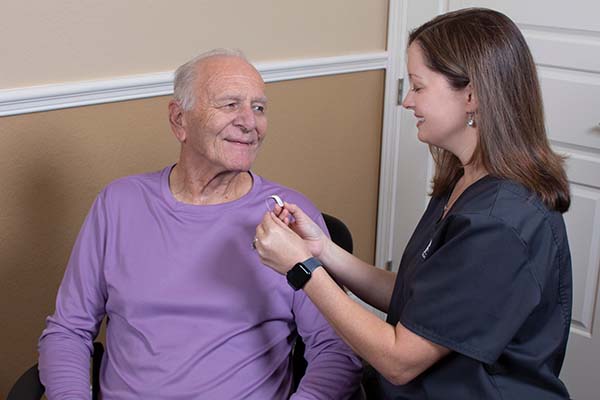
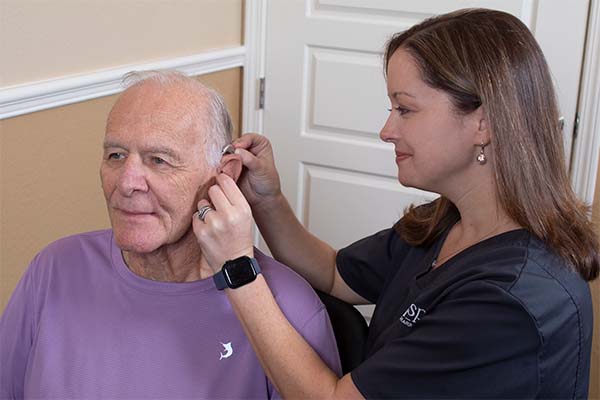
How Hearing Aids Work
The chip also analyzes and adjusts the sound based on your hearing loss, listening needs and the level of the sounds around you. The amplified signals are then converted back into sound waves and delivered to your ears through speakers.
There’s a reason digital hearing aids account for most hearing aids sold today. The quality of sound is amazing. Once you try a pair, you’ll see why they’re often the best choice.
Hearing aids vary by price, size and special features. The right choice for you also depends on your hearing needs and your lifestyle. The best way to select the right one is to get guidance from your local hearing experts. Call or text us today, and let’s talk.

Digital Hearing Aid Features
- Dual microphones allow you to hear better in noisy situations. Some can even identify the source of the noise and reduce it!
- Open technology that keeps the ear canal unobstructed eliminates that “talking in a barrel” effect.
- Feedback cancellation does just that — it cancels feedback before you hear it as an annoying whistle.
- Hands-free technology automatically adjusts to your listening environment, whether you are on the phone, in a crowd or in a windy area.
- Your digital hearing aid can be programmed with a computer to meet your individualized needs.
- Wireless technology allows you to hear your cell phone, television and home phone in stereo, directly through your hearing aids!
Hearing aids vary by price, size and special features. The right choice for you also depends on your hearing needs and your lifestyle. The best way to select the right one is to get guidance from your local hearing experts.

What you need to know about conventional (analog) hearing aids.
Questions about hearing aids? Call or text us today.
Which Type of Hearing Aid is Right for You?
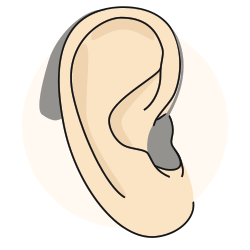
Behind the Ear (BTE) Hearing Aids
Recommended for: people of all ages and degrees of hearing loss.
BTE hearing aids are designed to give your ears an incredible boost in power. The plastic casing fits directly behind the top of your ear where it’s easily hidden by your hair.
The custom earmold is shaped to match the exact contours of your ear canal. It comes in a variety of colors to decrease visibility even more. The BTE hearing aid has a wide variety of programming features and options that may be customized to meet your hearing needs.
Open Fit Hearing Aids
Recommended for: mild to moderate hearing loss.
This style is a take on the BTE hearing aid with a thin tube. It doesn’t plug the ear and it’s not too visible. It keeps the ear canal open so that low-frequency sounds can enter your ears naturally while amplifying low-frequency sounds.
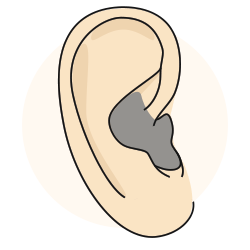
ITE / In the Ear Hearing Aids
Recommended for: people with disabilities or dexterity challenges who have mild to severe hearing loss.
ITE hearing aids are true custom-designed hearing aids. The entire hearing aid is molded to match the contours of your outer ear. The hard plastic casing forms to the exact shape of your ear making to fit snugly. There’s also an ITE style available that only fills the lower part. ITEs do a great job of amplifying sound.
You can add features to an ITE hearing aid to make it hassle free including telecoil (a feature that makes it easier to hear when you’re talking on the phone), ear to ear communication and automatic programming. ITE hearing aids comes in a variety of colors to match your skin tone including pink, beige, cocoa and brown.
RIC / Receiver in Canal or Receiver in the Ear (RITE) Hearing Aids
Recommended for: mild to severe hearing loss.
Our RIC or RITE hearing aids are perfect for active adults. The directional microphone technology makes it easier to understand conversations in crowded environments by detecting and amplifying the target speech signal and decreasing the background noise.
Visibility isn’t a problem. You can attend business meetings, parties and other social events without anyone even knowing you’re wearing hearing aids. You can hide the small hard plastic casing on this device behind your ear or underneath your hair.
The ultra-thin wire picks up sound and carries it directly into a speaker that fits invisibly into the ear canal or in the ear. The RIC hearing aid can come with programming features including bluetooth compatibility so you can connect your RIC hearing aids to your phone, your iPad or even your car.
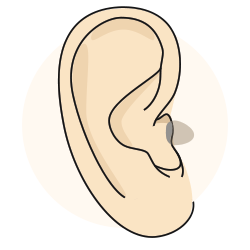
ITC / In the Canal Hearing Aids and CIC / Completely in the Canal Hearing Aids
Recommended for: mild to moderately severe hearing loss.
Our ITC and CIC hearing aids are our smallest, most invisible custom hearing aid products. The ITC hard plastic casing is tiny, ranging anywhere between 1 to 3 cm long. CICs are designed to fit even deeper into the ear canal resulting in a really invisible fit closer to the eardrum. CICs come with standard features and may have wireless capability.
Extended Wear Hearing Aids
Think invisible and almost maintenance free! You can wear these in-the-canal hearing aids 24/7 for months at a time, without having to worry about charging or replacing the batteries. The close proximity of the hearing aids to the eardrum ensures optimal sound while reducing distortion and background noise.
Special Hearing Aid Features
Many of our devices come with special programming features, including noise management programs, automatic adjustments, ear to ear communication, function controls, directional microphones, wireless bluetooth controls, music programs and telecoil. These features make it easier to communicate. The telecoil feature is also useful in public facilities with induction loop systems. Consult with our hearing professionals to determine which features are best for you!
Are Assistive Listening Devices the Solution?
Assistive listening devices
Augmentative and alternative communication devices
Alerting devices
FM systems use radio signals to transmit amplified sounds up to 300 feet. They’re useful in many public places such as classrooms, where the instructor wears a small microphone connected to a transmitter and the student listens via a worn receiver, which is tuned to a specific frequency or channel.
IR systems use infrared light to transmit sound. Unlike IL or FM systems, an IR system signal can’t pass through walls. It’s particularly useful in courtrooms, where confidential information is often discussed, and in buildings where competing signals can be a problem, such as classrooms or movie theaters. However, infrared systems can’t be used in environments with too many competing light sources, such as outdoors or in strongly lit rooms.
Personal amplifiers are useful in places where ALDs aren’t available or when you’re watching TV, being outdoors or traveling in a car. About the size of a cell phone, personal amplifiers increase sound levels and reduce background noise for a listener. Some have directional microphones that can be angled toward a speaker or other source of sound. As with other ALDs, listeners wear a receiver, either as a headset or earbuds, which picks up the amplified sound.
Real People. Real Stories.
Their words, not ours. See what more real people say about their experiences with Aspire Hearing in Lakeland, FL.


